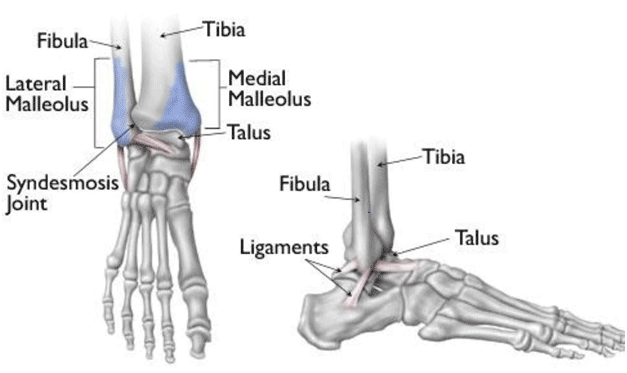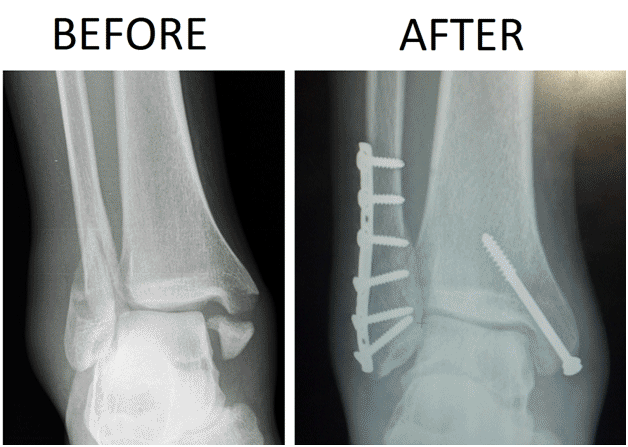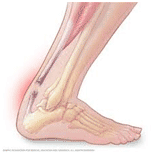Ankle injuries are among the most common injuries that athletes face, no matter which sport they choose to play. From basketball and soccer to running and gymnastics, the ankle is a crucial joint that bears a significant amount of stress and strain. We also need a good ankle to walk on uneven ground and to go up and down stairs. Normal activities of daily life can lead to ankle injuries as well. Understanding the types of injuries, how they are diagnosed, and the treatment options available can help patients recover effectively and prevent future occurrences.
Ankle Antomy. Not how the ligaments hold the bones together. Because of the shape of the bones and the connections provided by the ligaments, the ankle can move up and down and side to side allowing us to walk, run, jump and be stable on uneven ground.

There are several types of ankle injuries that we typically encounter. The most common is the ankle sprain, which occurs when the ligaments supporting the ankle stretch or tear, often due to a sudden twist or impact. Ligaments are thick structures that hold one bone close to another bone. Sprains can range from mild (Grade I) to severe (Grade III), with symptoms such as swelling, bruising, and limited mobility. Other common injuries include ankle fractures, which involve a break in one or more bones of the ankle. A break, or fracture can lead to inability to walk and significant swelling, usually more than is present with just a sprain. Often there is bruising as well. If you twist your ankle and feel a pop and have trouble walking at all, it is important to get an xray as soon as possible.

This is a common pattern of ankle fracture caused by a twisting injury. Patients will often feel a pop in their ankle with severe pain and will be unable to walk on that leg. Treatment is aimed at restoring the anatomy so that the bones and ligaments can heal in proper position.
The Achilles tendon is the tight band that attaches your calf muscle to your heel bone. It is important for walking and especially running. Achilles tendonitis is an “overuse” injury that can cause pain and weakness when trying to walk, run and jump. In addition, if you feel a painful pop in your heel and have a hard time walking you have ruptured or torn your Achilles tendon. This needs to be seen by a doctor trained in foot and ankle surgery as soon as possible.
 The Achilles tendon has ruptured and needs to be treated with either a cast or direct repair with sutures
The Achilles tendon has ruptured and needs to be treated with either a cast or direct repair with sutures
Ankle instability or “looseness” can occur over long periods of time as well. This can occur in people who have had repeated ankle sprains over the years and if you have this problem, your ankle may feel loose and you may have a hard time cutting or pushing off with the ankle as you play sports. This can be painful, usually on the outside part of the ankle.
Diagnosis of ankle injuries typically begins with a thorough medical history and physical examination. Healthcare professionals often assess the range of motion and the stability of the ankle joint. Imaging tests, such as X-rays or MRIs, may be performed to confirm the presence of fractures or to evaluate the amount of ligament damage. A correct diagnosis is crucial as it determines the treatment plan and helps predict recovery times. For instance, a severe sprain may require different management than a simple fracture.
When it comes to treatment options, they vary based on the type and severity of the injury. For mild sprains, the R.I.C.E. method (Rest, Ice, Compression, Elevation) is often sufficient, coupled with over-the-counter pain relief. More severe injuries, such as fractures or significant ligament tears, may necessitate immobilization in a cast or brace, and in some cases, surgical intervention. Physical therapy also plays a vital role in rehabilitation, helping athletes regain strength and flexibility while reducing the risk of re-injury. Recovery time can range from a few days for mild sprains to several months for more serious injuries, making following the treatment plan essential.

In conclusion, ankle injuries in sports can vary widely in type and severity, but with prompt diagnosis and appropriate treatment, patients can expect good outcomes. Understanding the nature of these injuries, the importance of a correct diagnosis, and the range of treatment options available allows patients to take control of their recovery. By prioritizing ankle health and engaging in preventive measures—such as proper warm-ups and stretching and strengthening exercises—athletes can reduce their risk of future injuries and continue to perform at their best.